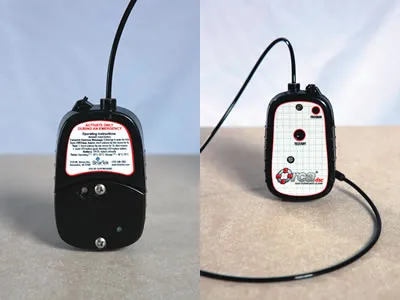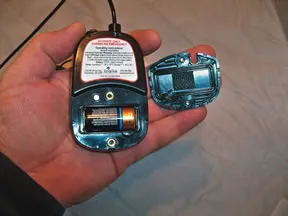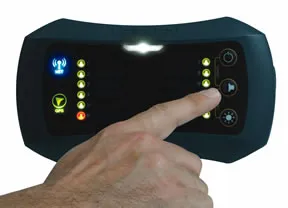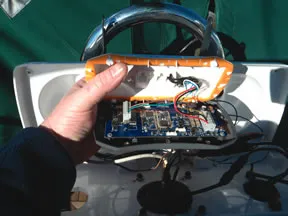
Photos by Frank Lanier
288
Man-overboard recovery devices and drills have always been an area that Practical Sailor has watched closely. In the past five years, PS has published more than a dozen articles aimed at reducing the risk of losing someone overboard at sea. These reports range from tests of safety harnesses and tethers designed to keep a person on board to extensive tests of man-overboard recovery drills. In our view, a jackline, harness, and sound seamanship skills are far more important than any man overboard (MOB) electronic alerting and tracking devices. However, new technology and intense competition in this area is yielding some promising new devices that deserve our attention.
This article follows up on a May 2008 report, in which testers looked at various MOB alarms and tracking devices. In that report, testers evaluated seven different products: the ACR ResQFix, two Mobilarm MOBilert systems, the Raymarine LifeTag, Emerald Marine’s Alert2, Marine Rescue’s Sea Marshall, and the SPOT messaging device. Based on the results of both on-the-water and bench testing, three devices earned Recommended ratings. Each of the Recommended products represented a different approach to the challenges of an MOB event.
For those cruisers who spend most of their time in regions with well-established search-and-rescue support, a third-generation 406-MHz personal locator beacon (PLB) such as the ACR ResQFix remains our fist pick in personal beacons. Built to stringent international standards, PLBs relay position data and identification information to rescue centers via satellite and land-based stations. Compared to other electronic MOB systems, the two chief drawbacks of a PLB is that it is not automatically activated, nor does it provide MOB position data directly to nearby boats. This information is instead relayed through designated rescue centers.

288
In addition to the PLB, two other types of devices are worth looking at. Sailors who are venturing into waters far beyond the help of shore-based rescuers might want to consider the Sea Marshall’s top-of-the-line SARfinder 1003 system. Officially classified as a Maritime Survivor Locating Device (MSLD), the SARfinder 1003 alerts the crew to a man overboard and then enables direction-finding technology to help guide a crew back to a man overboard. The Sea Marshall’s wearable device emits an internationally recognized 121.5-MHz homing signal, while the onboard direction-finding receiver can be connected to visual display, allowing the helmsman to steer directly toward the person in the water.
Finally, for those who are looking solely for an “electric fence” system that alerts the crew when someone goes over, testers liked the MOBilert 720i, with its compact wearable beacons. In this type of system, an onboard alarm is activated when a wearable beacon gets wet or moves outside a defined perimeter from the beacon base station installed on the boat. A few of the devices in this last category—such as the LifeTag system from Raymarine—also automatically entered an MOB waypoint if interfaced with a GPS receiver and chartplotter.
What We Tested
In this issue, we’ll report on the long-term testing of the MOBilert 7200, as well as evaluate its replacement. (Although still supported by Mobilarm, the MOBilert was discontinued last year.) We will also look at the ORCA-dsc, which was introduced early last year. Both of these MOB alarms are designed to alert the crew when a member goes overboard. Neither is capable of tracking the victim once he is in the water, so their effectiveness relies greatly on the crew’s quick reaction in the event of an emergency. It cannot be emphasized enough that PS regards all of these devices as a distant second to the time-tested practices designed to keep crew on board. None is a substitute for the regular use of harnesses and tethers, or routine practice of man-overboard drills.
How We Tested
For this test, reviewers carried out a series of environmental tests on the wearable “pendants,” submerging them in seawater for one hour, exposing them to 15-degree temperatures for four hours, and exposing them to 90-psi freshwater spray for two minutes. The units were also dropped four times onto a fiberglass deck from a height of 3 feet. After the completion of all of these environmental tests, the units were checked for proper operation. No pendant survived prolonged exposure to 250 degrees, an unlikely condition except in the event of a fire.
Features, price, warranty, ease of installation, quality of manuals and other supporting materials, and customer support were also factored into the ratings.
ORCAdsc
The ORCAdsc is a water-activated personal MOB alarm-beacon developed by U.S.-based BriarTek. In order to work, the system requires that you have a VHF radio with digital selective calling (DSC), a standard feature on any fixed VHF sold today. Weighing in at just over 3 ounces, the floating ORCAdsc is powered by a user-replaceable 3-volt CR123 lithium battery. When submerged for 4 to 6 seconds, the ORCAdsc automatically transmits both an alert to your DSC-enabled marine VHF radio and a homing beacon on 121.5 MHz, which can be used by search-and-rescue teams—or any craft equipped with a radio direction finder—to locate the MOB. (Although the 121.5-MHz signal has been phased out of the satellite-based COSPAS-SARSAT system, it is still a designated homing frequency for rescuers.)
This added direction-finding capability makes it possible for the remaining crew to use an onboard 121.5-Mhz direction finder, such as that used by the Sea Marshall system, to carry out a self-rescue. This capability, however, adds significantly to the cost, upwards from $2,000 for a commercial grade unit. (Orca sells its own commercial-grade direction finding system for $5,500.)
Some background on DSC technology is helpful to understand how the ORCAdsc unit works. Each DSC VHF radio is assigned a nine-digit Marine Mobile Safety Identification (MMSI) that the user should register with the proper regulatory authority. U.S. sailors can easily register a DSC radio for free through BoatU.S., Sea Tow, or U.S. Power Squadrons. U.S. sailors venturing abroad, however, must register their devices with the Federal Communications Commission. Foreign sailors need to register with their country’s respective regulatory body.
Pushing the red “Distress” button on a DSC-equipped radio sends out the MMSI, and gives rescuers key information about the vessel in distress and the nature of the distress. A DSC radio can also be linked to a GPS to automatically provide position data when transmitting. The MMSI also functions as a telephone number for your VHF, identifying you when making a call, and allowing others to call only you.
Most DSC VHF radios can also be programmed with a “group MMSI,” a single number shared by multiple vessels that can be used for calling a fleet of boats, a useful feature when participating in a race or organized rally.
The ORCAdsc comes pre-loaded with two BriarTek group MMSI numbers. When these numbers are programmed into your DSC radio, the ORCAdsc will “call” your ship’s VHF on DSC Channel 70 when submerged. This call will also be received by any other DSC-equipped vessel in range that has been similarly programmed to recognize the group MMSI number assigned to the pendant.
In addition to two pre-programmed group MMSIs, you can add one individual ID and one additional group ID. You can also program your own vessel’s MMSI number into the ORCAdsc, in which case, this MMSI and all group MMSIs would be transmitted. Entering your own MMSI, however, requires a drawn out series of stylus taps.
Having multiple ORCAdsc’s on one boat presents a minor technological problem. Whether these units use the permanently loaded BriarTek group number or the vessel’s MMSI number, it is not possible to know which unit (or person) has gone overboard. There is no way to identify which pendant is generating the alarm based solely on the MMSI number displayed on the radio. One way around this would be for each crewmember to apply for an MMSI number and load it into their assigned ORCAdsc unit, but it would be simpler to have each crew select his own group MMSI and program that into the unit. If you do decide to register each unit with a separate MMSI, it is advisable to add some identifying comments—such as Joe Smith’s ORCAdsc Pendant—in the “See Remarks” block in the registration forms. If you go this route, be sure to keep a separate record of which number is assigned to each particular pendant.
It is important to note that the call made to civilian ships by the immersed ORCAdsc is NOT the same as a DSC distress call. The tone generated by the call is that of an ordinary DSC call, and the volume of the tone will depend on the user’s radio volume. So the radio volume must be turned up, and the crew must be aware of the significance of the DSC tone. All ORCAdsc units made after March 8 have been pre-programmed with the U.S. Coast Guard’s Distress Group Call MMSI, which will also alert the Coast Guard. It is expected that U.S. regulatory agencies will soon allow a delayed “all ships” DSC distress call 30 minutes after initial activation.
Other features of the ORCAdsc include a small, automatically activated strobe and a 25-inch external antenna that doubles as a lanyard, allowing the unit to be worn around the neck. It can also be placed in a jacket chest pocket or pouch, with the antenna draped across the shoulders and secured on the opposite side of your chest. The lanyard is detachable at one end to accommodate this. In either configuration, the goal is to submerge the sensor on the unit’s body, activating transmission, but to keep the antenna as high as possible above water for maximum range. The unit will not transmit if the antenna is immersed.
The ORCAdsc has a DSC VHF alerting range of up to 1 nautical mile, while the homing beacon, with a 100mW of transmit power, has an advertised tracking range of 2 nautical miles from small craft, 5 nautical miles from a ship, and 20 nautical miles or greater from aircraft.
Battery life is one year in the “armed” or standby mode (i.e. battery installed) and 18 hours in the transmit mode.
Construction-wise, the ORCAdsc is robust and should be able to handle with ease the drops and bangs any piece of wearable gear will inevitably experience. BriarTek rates the unit as submersible to 10 meters. Testers also like the consumer replaceable battery option and the unit’s battery self-test feature (although it only verifies battery condition). The unit floats, an essential feature in our view.

288
If the unit is simply worn around the neck, it could come off when the wearer hits the water. Testers recommended some other means of securing it to one’s body, as does the maker. BriarTek sells a belt-mounted pouch that will fit most harnesses and life jackets (PFDs). We would not trust the pendant arrangement alone to keep the unit in place when tumbling into the drink.
Bottom line: Selling for $375, the ORCAdsc’s pricing (assuming one already has a DSC VHF) and fairly simple installation makes it an attractive option for those interested in a water-activated alerting and self-recovery system. As with any MOB device, the crew needs to be well versed in the unit’s limitations and proper operation.

Photos by Frank Lanier (No. 3 and below);
288

Photos by Frank Lanier (No. 3 and below);
288
Mobilarm MOBilert
After our 2008 review of MOB units, we installed Mobilarm’s MOBilert 7200 aboard one of our test boats (a 36-foot Union 36 based out of the Chesapeake Bay) for long-term evaluation. The MOBilert 7200 monitoring system comprises wearable pendants, an LCD display unit/base station, and pendant charging bay.
When the system is activated, the wearable devices and base station are linked by a short-range radio signal. An audible alarm is triggered when the radio signal between the wearable beacon and the base station is interrupted, typically because the beacon is in the water or out of range. The base station has a relay component that can actuate an MOB waypoint on its own LCD screen and any National Marine Electronics Association (NMEA) 0183-compatible GPS or chartplotter. It also has a relay-switching capability that can turn on various devices, such as an external horn or strobe.
Once linked to the base unit, each pendant is continually monitored for signal strength and battery charge level (with low-battery alarms provided at both pendant and console). There are various options for wearing the pendant to ensure it is submerged if someone falls overboard. Once the person is in the water, the pendants are no longer transmitting to the base unit, so there is no way to track the person in the water. If the unit is linked to a chartplotter, however, you can navigate to the spot where the beacon was activated.
With the display unit mounted at the helm, we noted during our long-term testing, that the internal MOB alarm was hard to hear from more than a few yards away, even less if the engine was running. It was certainly not audible from belowdecks. For that reason, we installed an external alarm (a small 12-volt DC horn) in the main cabin that could be heard throughout the vessel.
We also had problems with pendants that went into “sleep mode” and could not be roused back into service. These needed to be returned to the manufacturer and replaced. Initially, the MOBilert would generate false alarms when crewmembers were working on the bow. This was fixed by adding the external antenna.
Once the battery and range issues were addressed, the unit worked well. The interface was fairly intuitive, and the ability to name each pendant and monitor their status came in handy. Testers also found additional uses for the system, such as placing a pendant in the dinghy while at anchor, which would then generate an alarm if the painter came untied or someone tried to steal it.
Bottom line: The long-term test dampened our initial enthusiasm for this product, but it also revealed some important lessons. First, it is essential that any audible alarm is extremely loud, and this will typically require an external speaker. Second, pendants need to be routinely checked for proper operation by actually activating the alarm system on a regular basis. Finally, while a sealed, rechargeable pendant offers more robust form factor, replaceable rechargeable batteries seem to be a more practical approach to powering an MOB pendant.
Mobilarm Crewsafe Essentials
In December 2010, we removed the now discontinued MOBilert 7200 unit aboard our test boat and replaced it with one of Mobilarm’s new Crewsafe systems, a scalable, wireless network designed to monitor crew locations at all times. Mobilarm sent its Crewsafe Essentials package, which contains the minimal equipment needed to bring a system online: a Crewsafe Display Console, capable of monitoring up to 12 crewmembers; two wireless transceivers or pendants, called Crewsafe Tags; and a power dock to charge them. Larger vessels can upgrade to the Crewsafe Management System, an expanded version that includes additional routers, as well as crew tracking and management utilizing a Windows-based system or stand-alone display console.
In the Crewsafe system, each crewmember wears or carries a Crewsafe Tag that is connected to the network via one or more Crewsafe wireless routers, depending on the size of the vessel. The network detects any break in the signal—a man overboard, low battery, damaged pendant, pendant out of range or immersed—and automatically raises an alarm if the connection is not re-established within 10 seconds.
Like the MOBilert 7200, the Crewsafe network can interface with existing navigation systems and GPS. In an MOB emergency, it also automatically logs a waypoint on any NMEA 0183-compatible chartplotter to mark when and where the incident occurred.
Some key improvements we noted over the MOBilert line include: greater network coverage in terms of number of crew and size of vessel; expanded tag features including an on/off switch, a manual alarm, a vibration alert, and strobe light; alarms that can be activated manually by any device on the network; an extended tag battery life (up to 48 hours between recharges); shorter, four-hour recharge times; and replaceable tag batteries.
The tags are well made and sleek. At 2.8 ounces,they’re slightly lighter than the ORCAdsc, are comfortable to wear, and they float. They come with two styles of interchangeable, snap-on/off clips (open and closed). They can be attached easily to belts, clothing, life jackets or harnesses, and can be secured with additional lanyards or safety chains if needed. Testers did find that when changing the clips, you have to take extra care to ensure the small locking tab at the top of the unit “snaps” into place, otherwise the clip will appear to be securely closed, when it isn’t.
One thing we liked about the MOBi-lert was the ability to personalize each pendant on the MOBilert LCD display (crewmember name or initials, for example). This is still an option for the Windows-based Crewsafe Management System; however, the Crewsafe Essentials console instead uses numbered positions and multicolored LED lights that indicate pendant status. If you want to personalize these positions, Mobilarm provides blank adhesive tags that you label with permanent ink and affix to pendants and their respective display console position.
The MOBilert display also came with a protective storage cover, a simple feature that the Crewsafe display console could benefit from, particularly when installed in more exposed locations.
As to Crewsafe improvements, we like the manual distress feature and the fact that an alarm is registered at each of the pendants as well as the console. We also liked the expandable network coverage and replaceable pendant battery feature, although we’d prefer batteries that could be replaced by the user.
The Crewsafe also appears to have better range than the MOBilert did, or is at least better able to monitor pendants in the same area of coverage. The Crewsafe was able to cover the entire boat without the need for an external antenna. Larger craft would simply add additional routers as needed to provide expanded coverage.
Bottom line: The Crewsafe system won’t bring a vessel back to a victim who has drifted far from the point he went overboard, but it’s a well-constructed, well thought-out approach to crew management and will be particularly attractive for vessels with larger crews.

288
Conclusion
While technology is no substitute for a seaman-like approach to keeping crew on board, an MOB alarm system provides an extra level of safety, one that could mean the difference between putting your “quick stop” practice to use or waking up from a long nap, looking out the companionway hatch, and wondering where the helmsman is.
Two features make the ORCAdsc an attractive solution—price and the fact that it works with a standard DSC VHF radio, something most boats already have. The homing beacon is another big plus for self rescue, although with the additional, substantial cost of a DF unit.
We also like the features provided by the Crewsafe system, such as the generation of an MOB waypoint on the vessel’s chartplotter, as well as options like relays for louder, external alarms.
Although both systems worked well, we can also see future potential that would take their performance to the next level. Engineering the Crewsafe Tags to provide GPS data would be a huge plus, particularly where response time and MOB drift was a factor. Allowing MOB alarms like the ORCAdsc to generate an open ended, “all vessel” alert would also increase the chances of rescue. The technology exists. Mobilarm’s V100 unit transmits a DSC alarm and provides GPS data. And Kannad’s new Safelink R10, which is awaiting regulatory approval in the U.S., meshes with Automated Identification Systems. (See “More New MOB Alarms,” on right)
Another excellent item to carry regardless of what MOB system you have would be a waterproof, VHF handheld with DSC and GPS capabilities. Such a system would not help someone who is unconscious, but a conscious person in the water would be able to send a full DSC alert, his position, and call a boat in sight with directions—“I’m 100 yards off your port bow.”
As we concluded in our 2008 test, finding a one-size-fits all MOB alerting solution is a tricky proposition. The best course is to adhere to standard safety procedures for staying onboard (prudent use of jacklines, safety harnesses, etc), evaluate your cruising routes, and determine which MOB alarm system provides the options that best meet your particular needs.



































